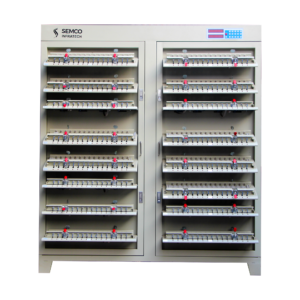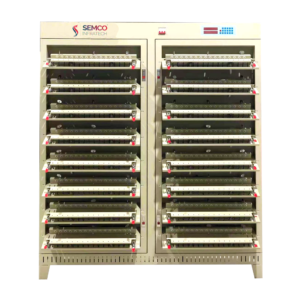SI CT 5V 3A 512CH – Linear/Energy Saving
Table Of Content
- Products Details
- Hardware Functions:
- Technical Specifications:
- Charging Process
- Overall Energy Saving Analysis
Product Details:
- The constant voltage and constant voltage charging is safe and smooth, and the voltage and current sampling output of the device is controlled through the four-wire system connection for a soft start, so as to make a safe and smooth transition in the constant voltage and constant voltage charging process to avoid the occurrence of peak damage,
- Each CH can perform constant current and constant voltage charge and constant current discharge tests on the 512 Cells that meet the voltage range,
- Using the constant current-constant voltage power supply of the invention patent, there is no impact from constant current to constant voltage switching, which is especially suitable for the requirements of the lithium-ion battery,
- Equipment and computer interface: the Ethernet interface between the equipment and computer can ensure stability and real-time remote data acquisition, and the operation of the equipment can be activated by the office network and remote monitoring workshop in real,
- Each battery fully has its own constant current and constant voltage source, and its own loop does not affect each,
- Real-time detection of each cell’s voltage, charging, the first constant current charging, when the battery voltage reaches the set value, will be smoothly transferred to constant voltage charging, to meet the set time or current termination conditions, and the charge is over. During constant current discharge, when the battery voltage is lower than the set value, the discharge is completed and the corresponding battery indicator lights,
- Multiple conditions (capacity, time, open circuit voltage, discharge platform, etc.) for battery,
- Automatically calculate the constant current charge ratio, capacity loss, discharge efficiency, average voltage, medium voltage, and other,
- This equipment is to test battery charge, discharge, and related characteristics. Through software programming, the operator can charge and discharge the battery with any current or voltage within the testing,
- Curve analysis and processing: curve analysis Can flexibly select the cycle that needs to be displayed, a variety of curve combinations (such as voltage, current, capacity-time, capacity-voltage; cycle times-charge-discharge end voltage and etc.); Graphics can be arbitrarily moved, horizontal/longitudinal magnified or reduced to check the voltage, current, Capacity, cell voltage, and other data details. Can compare one data file for different cycle data or compare several data file curves at one time.
Hardware Functions:
| S.No. | Function | Function Introduction |
| 1. | Charging | Constant-Current Charging (CC): The channel is output by a constant current with a soft start, and no current impact occurs. Constant-Voltage Charging (CV): The channel is output by constant voltage without limiting the output current (the output current is restrained by the maximum current value of the device’s model). CC-CV Charging: Restrain the output of voltage and current at the same time, and current. Hardware with soft start. No impact voltage and current during CC-CV transition. |
| 2. | Discharging | Constant-Current Discharging (CD): The channel is output by a constant current with a soft start, and no current impact occurs. Constant-Power Discharging (CP): The channel is in constant power discharge mode, and the channel adjusts the current in real-time according to the voltage of the battery port. Constant-Voltage Discharging (CV): The channel keeps the port battery voltage constant for discharge, and the current decreases gradually until the cut-off voltage is reached. |
| 3. | Standing (Rest) | The current circuit is cut off, without impact on data acquisition. |
| 4. | Stop | Channel stopped completely. The circuit of the battery and the machine are completely cut off. |
Technical Parameter:
| Model | SIB CT 5V 3A 512CH |
| Number of Device Channels | Total with 512 channels |
| Working Flow Control Method | Overall machines control |
| Charges Mode | Constant current, constant voltage |
| Charges Terminated Conditions | Voltage, current, time, capacity |
| Discharges Mode | Constant current |
| Discharges Terminated Conditions | Voltage, time, capacity |
| Protective Functions | Over-voltage, lack of voltage, over current lack of current over capacity protection, Reverse wiring protection, Outage protection, data breakpoint recovery. |
| Flow Setting | Maximum can seat 32 steps and 256 cycle |
| Sampling Inspection Cycle | ≤2s |
| Minimum Data Record Frequency | ≤4s |
| Equipment Conversion Efficiency | Charges: 75%, Discharges: 70% |
| Stability Measures | Adopts precise instrument purpose amplifier current automatic calibrate technology Software calibration cancels potentiometer calibration. |
| Sorting | Matching with internal resistance testing and battery sorting system, realize battery sorting. |
| Program Upgrade | Remote online upgrade |
| Software | Can recording voltage, current, time, and capacity such data with powerful data process functions provide multiple curve modes? Can output and create text, EXCEL, WORD, or MDB database format files. |
| Range of Voltage Measuring | Charges 0-5V;discharges 0-5V,resolution 0.1mV |
| Range of Battery Voltage | Charges 0-4.5V;discharges 4.5-2V |
| Range of Constant Voltage | 2-4.5V |
| Voltage Accuracy | ±(0.05%RD+0.05%FS) |
| Range of Current | Charges 0.015A-3A;discharges 0.015-3A,resolution 1mA |
| Current Accuracy | ±(0.15%RD+0.05%FS) |
| Range of Time | Within 0-30000 mins sets randomly, the time unit is minute |
| Time Accuracy | ≤±0.1% |
| Temperature Measuring | Measuring range-10 ~ +80℃,resolution 0.1℃,accuracy±1.5℃ |
| Input Power | 5 AC380V±1 0%,50HZ,dissipation≤10KW |
| Communication Mode | TCPIP |
| Battery Clamp | Quick fixture (18650, 21700, 26650, 32650) |
| Dimension (W×D×H) | 1760*730*1850mm |
| Working Ambient | Temperature:0~40℃,relative humidity ≤85% |
| Weight | 300kg |
1. Working Principle Of Energy‑Saving Battery‑Based Component Capacitor Equipment Based On High‑Frequency Power Feedback Technology:
- Battery Charging Mode
- Charging mode: using PWM switching power supply mode to achieve constant current and constant voltage charging of the battery
- Features: high power conversion efficiency, generally above 85%
2. Battery Charging Mode:
- Discharge mode: First, use the PWM boost circuit to increase the battery voltage and then send it to the first‑stage DC power supply, and then increase it step by step finally, it is converted into AC power and sent to the AC grid, and finally the battery discharged power is fed back and,
- Features: The discharged electric energy of the battery is well recycled and reused, Obvious energy saving.
3. The Overall Composition And Working Principle Of The Equipment:
4. High‑Frequency Energy Feedback Technology:
- What is electric energy feedback technology?
- The technology of inverting DC regenerative electric energy such as batteries into AC and sending it back to the grid is called electric energy feedback,
- Main types of electric energy feedback technology,
- Active inverter power feedback technology based on thyristor (SCR),
- Electric energy feedback technology based on high‑frequency PWM rectification technology of fully‑controlled devices,
- Active inverter power feedback technology based on thyristor (SCR),
Features: AC Side Current Is Sine Wave, No Harmonic Pollution To The Power Grid; Power Factor Can Be Controlled To 1.
Charging Process
Q-1: Power Consumption In Traditional Mode.
Ans – Take a lithium‑ion battery as an example. If it is charged with a current of 2A, a single battery needs to be consumed due to the linear regulated power supply mode.14WOf electricity.
Q-2: Energy‑Saving Mode Power Consumption.
Ans – This project uses switch mode charging, if charging at 2A, the maximum power consumption of a single battery is 8.4W, considering the efficiency of 85%, the maximum power consumption is9.9W, 4.2 Energy saving during discharge.
Q-3: Power Consumption In Traditional Mode.
Ans – Traditionally, it is consumed in the form of heat, no electricity is returned to the grid, and basically no energy is consumed from the grid.
Q-4: Power Consumption Of This Project Mode.
Ans – This project adopts the electric energy feedback method, if the discharge is 2A, the maximum discharged electric energy of a single battery is 8.4W, considering the efficiency of 85%, the actual energy is recovered at 7.1W.
Overall Energy Saving Analysis
Q-1: Total Energy Consumption In Traditional Mode.
Ans – The charging process consumes 14W, and the discharging does not consume power. Total power consumption is 14W
Q-2: This Energy‑Saving Mode Consumes Power.
Ans – The charging process consumes 9.9 watts, and the discharged electric energy is ‑7.1W, Actual total power consumption for 9.9‑7.1=2.8W.
Q-3: Power Saving Efficiency Of This Energy Saving Mode.
Ans – Compared with the traditional model, the power saving efficiency is: (14‑2.8)/14=80%. In practice, considering the loss of each link and the power loss of the battery itself, the actual measurement can reach 50% Power saving efficiency.



